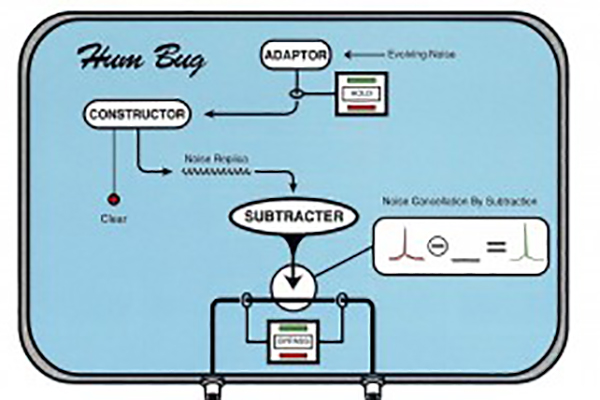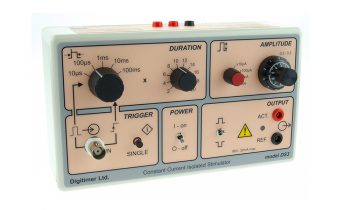Description
DESCRIPTION
The Hum Bug Noise Eliminator is the ideal piece of biological research technology, aiding in the removal of mains or line noise (50/60Hz) in signal readings from biological sensors and high impedance devices, without the signal degradation associated with notch filters.
Need to remove noise from more than one channel?
Those of you wanting to remove mains interference from multiple channels can use more than one Hum Bug, but they are not inexpensive devices. Fortunately, Digitimer have developed our new D400 Two, Four & Eight Channel Main Noise Eliminators for cost-effective mains noise removal in multi-channel recording applications. The D400-2, D400-4 and D400-8 remove mains noise from signals using a similar approach to the Hum Bug, but do so independently for several channels, even making it possible to share a single D400 across multiple rigs.
The Problem
- Signals recorded using biological sensors and other high impedance devices are often contaminated with 50 or 60 Hz noise corrupting the content of these signals and degrading the quality of subsequent data analysis.
- Electrical interference is notoriously difficult to remove without altering the original signal embedded within the noise.
- In theory, proper attention to ground and appropriate shielding can eliminate electrical interference. In practice, noise remains a frequent and distressing problem in many laboratories.
- Noise may come and go for no apparent reason and may appear during critical phases of data collection. The effort required to maintain noise at an acceptable level is both time consuming and frustrating.
The Traditional Approach
- Faraday cages decrease the magnitude of environmental noise sources, but this protection is often incomplete.
- Notch or comb mains noise eliminator filters are occasionally used to suppress 50/60 Hz noise and harmonics but a line noise filter will distort the input waveform if the frequency components of the signal overlap with the filtered frequencies.
A New Solution – 50 or 60Hz Noise Removal without Filtering
- Developed by Quest Scientific and now redesigned, manufactured and supplied by Digitimer, the HumBug uses a powerful new technique – 50Hz noise eliminator or 60 Hz noise removal from analogue signals without filtering.
- The Hum Bug noise eliminator constructs a noise replica in real time and continuously subtracts this replica from the input signal. It performs this function in the presence of biological activity even when noise characteristics evolve over time.
- Even if the biological signal has 50Hz or 60Hz components, these will be untouched by the Hum Bug Noise Eliminator.

Simplicity
- The Hum Bug Noise Eliminator is a real-time device. Simply connect it between your preamplifier and any analysis or recording equipment (oscilloscope etc.).
- It will automatically eliminate electrical interference while it lets the signal of interest pass through unchanged. No settings or adjustments are required.
- The front panel switches are only used if you wish to bypass noise cancellation (BYPASS), stop the adaptation process (HOLD), or clear the noise replica (CLEAR).
GALLERY
DOWNLOADS
FAQS
The HumBug is NOT a mains noise filter, making this the main reason it is a special, perhaps unique product. Filtering often results in phase shifts, frequency loss, amplitude errors, DC shifts, time delays or digital distortion. The HumBug will eliminate 50/60Hz electrical interference (and harmonics) without altering your signal of interest.
A noisy waveform is the summation of two separate components. One component is the biological signal of interest and the other is noise of various forms. These forms of noise include random fluctuations generated by the sensor, amplifier and background biological noise in the vicinity of an experimental setup. The HumBug is designed to cancel electrical interference. It constructs a replica of noise embedded within the input signal and subtracts this replica from the noisy signal as it passes through the device. The end result is an output which contains only the signal of interest – mains noise removal without filtering.
The HumBug adapts rapidly when the input signal is dominated by noise and proceeds more slowly when low amplitude noise is embedded within continuous physiological activity. Adaptation is also slower for harmonics with frequencies greater than 1kHz.
Yes, but please remember that the HumBug is a single channel device, therefore you will need one HumBug for each channel of interest. We would recommend that you consider our D400 Multi-Channel Noise Eliminator as an alternative, as it was specifically developed for use with multi-channel amplifiers or when multiple signals are being processed.
First you should check that the HumBug is configured to remove noise of the appropriate frequency. You can check this as it should be indicated next to the power connection socket on the back of the unit. It may be possible that the noise you are experiencing is not picked up from the mains supply. If the peak to peak noise is too large for the HumBug to completely cancel. If so, the indicator will continue to flash red. The HumBug cannot eliminate noise greater that 1V peak to peak. Likewise, low amplitude noise (<15mv) can be difficult to remove, so it is suggested that you increase the gain of your signal to ensure that the amplitude is greater than 15mV peak to peak.
It is possible, but not as easy as it seems to be at first glance. The problem is, that the EPC 10 has no Current In AD channel. The current signal from the amplifier board is hard wired with the AD converter inside the housing of the amplifier. Therefore it is not possible to connect the output of Filter 1 or Filter 2 via the HumBug and a Current In AD.
One would have to use one of the free AD inputs of the EPC 10 for reading the current signal. This has some drawbacks: the “real” current AD is automatically scaled by the “gain” that is set in the amplifier dialog. This is not the case for other AD inputs. As a consequence, you would have to scale the AD input manually (in the configuration dialog). This is no problem as long the gain is kept at the same value during an experiment. However, if the gain is changed frequently, then it might become annoying to change the AD scaling in the configuration many times.
Older Quest Scientific Humbugs, intended for the European (220V) market are specifically manufactured for the local mains voltage and will not operate when connected to a 110V supply. There is a relatively easy hardware modification that switches it to be compatible with a 110V supply, but it does need the Humbug enclosure to be opened up and use of a soldering iron. For details, please get in touch with us and we can provide guidance. Note that our new D400 Multi-channel Noise Eliminator and the recently redesigned Digitimer Humbug operates with 110V or 220V supplies and just needs a fuse change when switching between the two.






